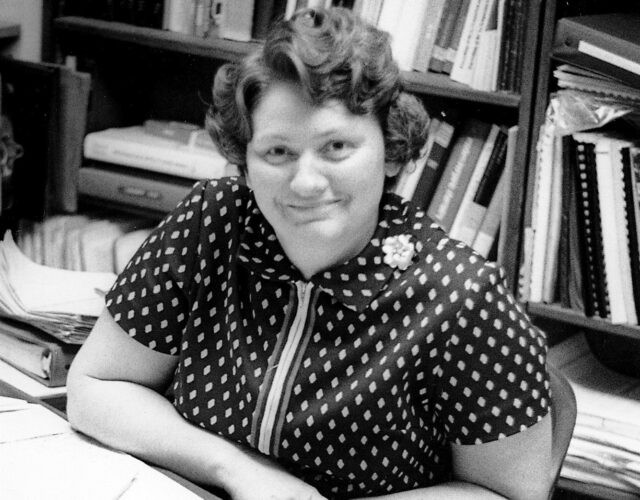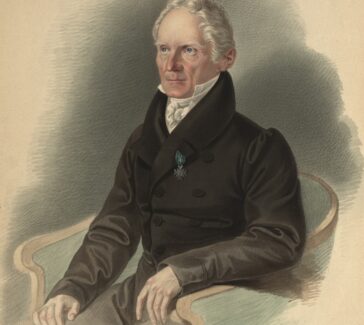Mary Lowe Good
From positions in academia, industry, and the corridors of political decision making in Washington, D.C., Good championed science and technology.

Mary Lowe Good took a public stand as an advocate of science and technology in society. Her advocacy earned her appointments to the National Science Board, the President’s Council of Advisors on Science and Technology, and the Department of Commerce.
Captivated by Chemistry
Mary Lowe (1931–2019) was born in Grapevine, Texas, the child of two teachers. In 1943 her family left Texas for Kirby, Arkansas, where her father was offered a job as school principal. She didn’t envision the head-spinning list of accomplishments that awaited her when setting off for college at the University of Central Arkansas. She planned to become a home-economics teacher, a well-paying job for women at the time.
But one day in a required chemistry course Good learned about Marie Curie and was captivated by her scientific achievements. She took a chance and switched her major to chemistry. She earned her bachelor’s degree and then continued her chemical education at the University of Arkansas, receiving her PhD in 1955.
During this time she also met and married William J. Good, who was a graduate student studying physics. Mary Good then joined the chemistry faculty at Louisiana State University (LSU) in Baton Rouge, where she became an assistant professor. In 1958 LSU opened a new campus in New Orleans, and both of the Goods were asked to serve on the faculty there. Good spent the next 20 years of her career in New Orleans.
LEARN MORE
Biography is one way of learning about a person. Oral history is another. Spend a few minutes listening to Mary Lowe Good’s interview archived by the Science History Institute’s Center for Oral History. What do you hear? Has the recording picked up background noises, interesting accents, nervous laughter, or meaningful pauses? What might these tell you about the interview context, who is speaking, or how the speakers feel about the memories being discussed? What do think you can learn about Mary Lowe Good from her oral history that is different from the content of this biography?
Pioneering Mössbauer Spectroscopy
In 1967, as a chemistry professor, Good pioneered an experimental technique called Mössbauer spectroscopy. With this technology she could learn in an afternoon what previously would have taken an entire year of study. Spectroscopy uses the interactions between matter and electromagnetic radiation, such as infrared radiation and visible light, to answer chemical and physical questions. Mössbauer spectroscopy, which uses gamma rays, is particularly useful for figuring out the molecular structure of complicated compounds containing metal ions. Good used the technique to study compounds containing the metallic element ruthenium.
Switching to Industry
In 1978 she returned to LSU’s main campus in Baton Rouge after being appointed the Boyd Professor of Chemistry, the chemistry department’s highest honor. She did not stay there long, though, leaving LSU in 1980 to become vice president and director of research for Universal Oil Products.
She remained in industry for 13 years, staying with the same company through several mergers and name changes, directing research and working on innovative technologies, such as the development of processes to remedy hazardous waste streams using hydroprocessing. She was vice president of technology at Allied-Signal when she left the firm in 1993. Along the way she pursued other activities, including one year as president of the American Chemical Society.

Heading to Washington, D.C.
Then Good headed for a third career. Her involvement with government began in the 1970s, when she served on the National Science Board, first under President Jimmy Carter and then under President Ronald Reagan. Good was the first woman to lead this important group, which directs much of the government’s support for research.
In 1991 President George H. W. Bush appointed her to his Council of Advisors on Science and Technology. All of these were part-time jobs, but in 1993 she went to work in government full-time as the undersecretary for technology in the U.S. Department of Commerce under President Bill Clinton, a position she held for four years. In this role she encouraged government, industry, and universities to work together.
Coming Full Circle
After leaving government Good returned to academia, taking a position at the University of Arkansas, her alma mater. She was also a managing member of the Fund for Arkansas’ Future, an organization that aims to foster high-tech business and industry in Arkansas, and served on the boards of several companies.
Recognition
In 1997 Good became the first woman to receive the Priestley Medal, the highest honor given by the American Chemical Society. In 2000 fellow scientists further honored her with the presidency of the American Association for the Advancement of Science.
She was also elected to the National Academy of Engineering in 1987 and has received numerous other awards, including the National Science Foundation Distinguished Public Service Award.
Good was honored with the American Institute of Chemists’ Gold Medal in 1983 and was awarded the 1998 Othmer Gold Medal for her multiple, distinguished careers in academia, industrial research, and public service that enriched our chemical heritage and helped ensure our future. She delivered the very first Ullyot Public Affairs Lecture in 1990 at the Chemical Heritage Foundation, now the Science History Institute, giving a talk titled “Chemically Based Technology for 2010.”



